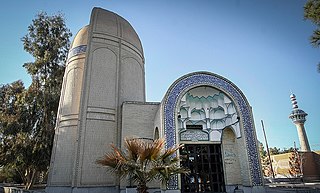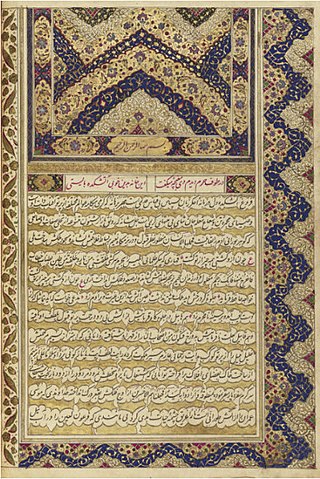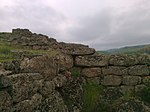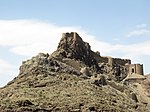
Abbas I, commonly known as Abbas the Great, was the fifth shah of Safavid Iran from 1588 to 1629. He is generally considered one of the greatest rulers of Iranian history and the Safavid dynasty. He was the third son of Shah Mohammad Khodabanda.

The Arg-e Bam, located in the city of Bam, Kerman Province of southeastern Iran, is the largest adobe building in the world. The entire building was a large fortress containing the citadel, but because the citadel dominates the ruins, the entire fortress is now named Bam Citadel.

Agha Mohammad Khan Qajar, also known by his regnal name of Agha Mohammad Shah, was the founder of the Qajar dynasty of Iran, ruling from 1789 to 1797 as king (shah). Originally chieftain of the Quwanlu branch of the Qajar tribe, Agha Mohammad Khan was enthroned as the king of Iran in 1789, but was not officially crowned until March 1796, having deposed Lotf Ali Khan of the Zand dynasty in 1794. Agha Mohammad Khan Qajar was famously the eunuch Monarch, being castrated as a young adult upon his capture by Adel Shah Afshar, and hence was childless. He was assassinated on 17 June 1797, and was succeeded by his nephew, Fath-Ali Shah Qajar.

Mohammad Shah was the third Qajar shah of Iran from 1834 to 1848, having succeeded his grandfather Fath-Ali Shah. From a young age, Mohammad Mirza was under the tutelage of Haji Mirza Aqasi, a local dervish from Tabriz whose teachings influenced the young prince to become a Sufi-king later in his life. After his father Abbas Mirza died in 1833, Mohammad Mirza became the Crown Prince of Iran and was conferred the title of Governor of Azarbaijan. Not long after, Fath-Ali Shah died on his way to Shiraz, leading some of his sons—including Ali Shah Mirza and Hossein Ali Mirza—to revolt but Mohammad Shah, with the support of his grand vizier, Abol-Qasem Qa'em-Maqam, suppressed the rebellions and asserted his authority.

Qazvin is a city in the Central District of Qazvin County, Qazvin province, Iran, and serves as capital of the district, county, and province. It is the largest city in Qazvin province.

Kashan is a city in the northern part of Isfahan province, Iran. At the 2016 census, its population was 304,487 in 90,828 families.

Iranian architecture or Persian architecture is the architecture of Iran and parts of the rest of West Asia, the Caucasus and Central Asia. Its history dates back to at least 5,000 BC with characteristic examples distributed over a vast area from Turkey and Iraq to Uzbekistan and Tajikistan, and from the Caucasus to Zanzibar. Persian buildings vary from peasant huts to tea houses, and garden pavilions to "some of the most majestic structures the world has ever seen". In addition to historic gates, palaces, and mosques, the rapid growth of cities such as the capital Tehran has brought about a wave of demolition and new construction.

Furg Citadel,, is an 18th-century citadel located in Furg Village in Darmian County, South Khorasan, Iran.

Abbas II was the seventh Shah of Safavid Iran, ruling from 1642 to 1666. As the eldest son of Safi and his Circassian wife, Anna Khanum, he inherited the throne when he was nine, and had to rely on a regency led by Saru Taqi, the erstwhile grand vizier of his father, to govern in his place. During the regency, Abbas received formal kingly education that until then, he had been denied. In 1645, at age fifteen, he was able to remove Saru Taqi from power, and after purging the bureaucracy ranks, asserted his authority over his court and began his absolute rule.

Kashan County is in Isfahan province, Iran. The capital of the county is the city of Kashan. At the 2006 census, the county's population was 297,000 in 81,816 households. The following census in 2011 counted 323,371 people in 95,260 households. At the 2016 census, the county's population was 364,482 in 112,258 households.

The recapture of Baghdad was the second conquest of the city by the Ottoman Empire as a part of the Ottoman–Safavid War of 1623–1639.

Iranian Armenia (1502–1828) refers to the period of Eastern Armenia during the early-modern and late-modern era when it was part of the Iranian empire. Armenians have a history of being divided since the time of the Byzantine Empire and the Sassanid Empire, in the early 5th century. While the two sides of Armenia were sometimes reunited, this became a permanent aspect of the Armenian people.

Siege of Tabriz is a military conflict during the Safavid-Ottoman war of 1603-1618. As a result of a successful siege, Tabriz was returned to the Safavid Empire after 18 years of Ottoman possession.

Hajji Ebrahim Shirazi, who is also known by his honorific title E'temad-al-Dawla, was an Iranian statesman who served as the kalantar of the city of Shiraz during the late Zand era and later as the first grand vizier of Qajar Iran.

Takht-e Foulad is a historical cemetery in Isfahan, Iran. The cemetery is at least 800 years old. In the 13th century in the Ilkhanid era Takht-e Foulad was the most important cemetery in Isfahan and all of the famous personalities have a mausoleum in this cemetery. Unfortunately all of the mausoleums from the Ilkhanid era, except Baba Rokn ed-Din mausoleum, which is the oldest structure in Takht-e Foulad, have been destroyed. In the Safavid era there were 400 mausoleums in Takht-e Foulad, but there are now only 8 mausoleums from the Safavid era. In the Qajar era a large part of the cemetery was destroyed, but the cemetery hasn't lost its importance and by the end of Pahlavi era it was the most important cemetery in Isfahan. There are 20 structures from the Qajar era and 17 structures from the Pahlavi era in the cemetery. Before the Safavid age the cemetery had been known as Lessan ol-Arz and Baba Rokn ed-Din, but from the Safavid age until now its name is Takht-e Foulad.

The conquest of Khorasan by Safavid loyalist forces against separatists in Khorasan was Nader Shah's first major military campaign which he waged on behalf of the new Safavid pretender to the throne, Tahmasp II. It would propel him into the centre of the political landscape of war torn early eighteenth century Persia.
Zeynab Begum was the fourth daughter of Safavid king (shah) Tahmasp I, is considered to be one of the most influential and powerful princesses of the Safavid era. She lived during the reigns of five successive Safavid monarchs, and apart from holding diverse functions, including at the top of the empire's bureaucratic system, she was also the leading matriarch in the royal harem for many years, and acted on occasion as kingmaker. She reached the apex of her influence during the reign of King Safi. In numerous contemporaneous sources, she was praised as a "mainstay of political moderation and wisdom in Safavid court politics". She was eventually removed from power by Safi in 1632.

Hajji Lotf-Ali Beg Azar Bigdeli, better known as Azar Bigdeli, was an Iranian anthologist and poet. He is principally known for his biographical anthology of some 850 Persian-writing poets, the Atashkadeh-ye Azar, which he dedicated to Iranian ruler Karim Khan Zand. Written in Persian, the Persian studies academic J.T.P. de Bruijn considers it "the most important Persian anthology of the eighteenth century". Azar was a leading figure of the bazgasht-e adabi movement, which sought to return the stylistic standards of early Persian poetry.

The Isfahan Seminary is one of the oldest seminaries in Isfahan, Iran. Currently, more than 40 schools in Isfahan province are under the supervision of the Management Center of Isfahan Seminary and the leadership of the supreme authority of Grand Ayatollah Hossein Mazaheri.







































